Rapid Room-Temperature Synthesis of Mesoporous TiO2 Sub-Microspheres and Their Enhanced Light Harvesting in Dye-Sensitized Solar Cells
Abstract
:1. Introduction
2. Materials and Methods
3. Results and Discussion
4. Conclusions
Author Contributions
Funding
Conflicts of Interest
References
- O’Regan, B.; Grätzel, M. A low-cost, high-efficiency solar cell based on dye-sensitized colloidal TiO2 films. Nature 1991, 353, 737–740. [Google Scholar] [CrossRef]
- Grätzel, M. Dye-sensitized solar cells. J. Photochem. Photobiol. C Photochem. Rev. 2003, 4, 145–153. [Google Scholar] [CrossRef]
- Wang, Q.; Ito, S.; Grätzel, M.; Fabregat-Santiago, F.; Mora-Seró, I.; Bisquert, J.; Bessho, T.; Imai, H. Characteristics of high efficiency dye-sensitized solar cells. J. Phys. Chem. B 2006, 110, 25210–25221. [Google Scholar] [CrossRef]
- Hardin, B.E.; Snaith, H.J.; McGehee, M.D. The renaissance of dye-sensitized solar cells. Nat. Photonics 2012, 6, 162. [Google Scholar] [CrossRef]
- Ren, Y.; Sun, D.; Cao, Y.; Tsao, H.N.; Yuan, Y.; Zakeeruddin, S.M.; Wang, P.; Grätzel, M. A Stable Blue Photosensitizer for Color Palette of Dye-Sensitized Solar Cells Reaching 12.6% Efficiency. J. Am. Chem. Soc. 2018, 140, 2405–2408. [Google Scholar] [CrossRef] [PubMed]
- Zhang, W.; Wu, Y.; Bahng, H.W.; Cao, Y.; Yi, C.; Saygili, Y.; Luo, J.; Liu, Y.; Kavan, L.; Moser, J.E.; et al. Comprehensive control of voltage loss enables 11.7% efficient solid-state dye-sensitized solar cells. Energy Environ. Sci. 2018, 11, 1779–1787. [Google Scholar] [CrossRef] [Green Version]
- Cole, J.M.; Pepe, G.; Al Bahri, O.K.; Cooper, C.B. Cosensitization in Dye-Sensitized Solar Cells. Chem. Rev. 2019, 119, 7279–7327. [Google Scholar] [CrossRef]
- Ghaithan, H.M.; Qaid, S.M.H.; Hezam, M.; Labis, J.P.; Alduraibi, M.; Bedja, I.M.; Aldwayyan, A.S. Laser induced photocurrent and photovoltage transient measurements of dye-sensitized solar cells based on TiO2 nanosheets and TiO2 nanoparticles. Electrochim. Acta 2016, 212, 992–997. [Google Scholar] [CrossRef]
- Mahmood, K.; Swain, B.S.; Amassian, A. Highly efficient hybrid photovoltaics based on hyperbranched three-dimensional TiO2 electron transporting materials. Adv. Mater. 2015, 27, 2859–2865. [Google Scholar] [CrossRef]
- Yu, H.; Zhang, S.; Zhao, H.; Xue, B.; Liu, P.; Will, G. High-performance TiO2 photoanode with an efficient electron transport network for dye-sensitized solar cells. J. Phys. Chem. C 2009, 113, 16277–16282. [Google Scholar] [CrossRef]
- Hore, S.; Vetter, C.; Kern, R.; Smit, H.; Hinsch, A. Influence of scattering layers on efficiency of dye-sensitized solar cells. Sol. Energy Mater. Sol. Cells 2006, 90, 1176–1188. [Google Scholar] [CrossRef]
- Koo, H.J.; Park, J.; Yoo, B.; Yoo, K.; Kim, K.; Park, N.G. Size-dependent scattering efficiency in dye-sensitized solar cell. Inorg. Chim. Acta 2008, 361, 677–683. [Google Scholar] [CrossRef]
- Hu, L.; Dai, S.; Weng, J.; Xiao, S.; Sui, Y.; Huang, Y.; Chen, S.; Kong, F.; Pan, X.; Liang, L.; et al. Microstructure design of nanoporous TiO2 photoelectrodes for dye-sensitized solar cell modules. J. Phys. Chem. B 2007, 111, 358–362. [Google Scholar] [CrossRef] [PubMed]
- Kang, S.H.; Kim, J.Y.; Kim, H.S.; Koh, H.D.; Lee, J.S.; Sung, Y.E. Influence of light scattering particles in the TiO2 photoelectrode for solid-state dye-sensitized solar cell. J. Photochem. Photobiol. A Chem. 2008, 200, 294–300. [Google Scholar] [CrossRef]
- Lee, J.K.; Jeong, B.H.; Jang, S.I.; Kim, Y.G.; Jang, Y.W.; Lee, S.B.; Kim, M.R. Preparations of TiO 2 pastes and its application to light-scattering layer for dye-sensitized solar cells. J. Ind. Eng. Chem. 2009, 15, 724–729. [Google Scholar] [CrossRef]
- Hore, S.; Nitz, P.; Vetter, C.; Prahl, C.; Niggemann, M.; Kern, R. Scattering spherical voids in nanocrystalline TiO2—Enhancement of efficiency in dye-sensitized solar cells. Chem. Commun. 2005, 15, 2011–2013. [Google Scholar] [CrossRef]
- Trang Pham, T.T.; Bessho, T.; Mathews, N.; Zakeeruddin, S.M.; Lam, Y.M.; Mhaisalkar, S.; Grätzel, M. Light scattering enhancement from sub-micrometer cavities in the photoanode for dye-sensitized solar cells. J. Mater. Chem. 2012, 22, 16201–16204. [Google Scholar] [CrossRef]
- Nishimura, S.; Abrams, N.; Lewis, B.A.; Halaoui, L.I.; Mallouk, T.E.; Benkstein, K.D.; Van de Lagemaat, J.; Frank, A.J. Standing wave enhancement of red absorbance and photocurrent in dye-sensitized titanium dioxide photoelectrodes coupled to photonic crystals. J. Am. Chem. Soc. 2003, 125, 6306–6310. [Google Scholar] [CrossRef]
- Mihi, A.; Calvo, M.E.; Anta, J.A.; Míguez, H. Spectral response of opal-based dye-sensitized solar cells. J. Phys. Chem. C 2008, 112, 13–17. [Google Scholar] [CrossRef] [Green Version]
- Lee, S.H.A.; Abrams, N.M.; Hoertz, P.G.; Barber, G.D.; Halaoui, L.I.; Mallouk, T.E. Coupling of titania inverse opals to nanocrystalline titania layers in dye-sensitized solar cells. J. Phys. Chem. B 2008, 112, 14415–14421. [Google Scholar] [CrossRef]
- Han, S.H.; Lee, S.; Shin, H.; Jung, H.S. A quasi-inverse opal layer based on highly crystalline TiO 2 nanoparticles: A new light-scattering layer in dye-sensitized solar cells. Adv. Energy Mater. 2011, 1, 546–550. [Google Scholar] [CrossRef]
- Huang, F.; Chen, D.; Zhang, X.L.; Caruso, R.A.; Cheng, Y.B. Dual-function scattering layer of submicrometer-sized mesoporous TiO 2 beads for high-efficiency dyesensitized solar cells. Adv. Funct. Mater. 2010, 20, 1301–1305. [Google Scholar] [CrossRef]
- Sun, W.; Sun, K.; Peng, T.; You, S.; Liu, H.; Liang, L.; Guo, S.; Zhao, X.Z. Constructing hierarchical fastener-like spheres from anatase TiO 2 nanosheets with exposed {001} facets for high-performance dye-sensitized solar cells. J. Power Sources 2014, 262, 86–92. [Google Scholar] [CrossRef]
- Sun, W.; Peng, T.; Liu, Y.; Yu, W.; Zhang, K.; Mehnane, H.F.; Bu, C.; Guo, S.; Zhao, X.Z. Layer-by-layer self-assembly of tio2 hierarchical nanosheets with exposed {001} facets as an effective bifunctional layer for dye-sensitized solar cells. ACS Appl. Mater. Interfaces 2014, 6, 9144–9149. [Google Scholar] [CrossRef] [PubMed]
- Liu, P.; Li, Y.; Hu, Y.; Hou, X.; Li, C. Macro-mesoporous TiO2 Microspheres for Highly Efficient Dye-Sensitized Solar Cells. Ind. Eng. Chem. Res. 2015, 54, 6692–6697. [Google Scholar] [CrossRef]
- Park, N.G. Light management in dye-sensitized solar cell. Korean J. Chem. Eng. 2010, 27, 375–384. [Google Scholar] [CrossRef]
- Chen, D.; Huang, F.; Cheng, Y.B.; Caruso, R.A. Mesoporous anatase TiO2 beads with high surface areas and controllable pore sizes: A superior candidate for high-performance dye-sensitized solar cells. Adv. Mater. 2009, 21, 2206–2210. [Google Scholar] [CrossRef]
- Chen, D.; Cao, L.; Huang, F.; Imperial, P.; Cheng, Y.B.; Caruso, R.A. Synthesis of monodisperse mesoporous titania beads with controllable diameter, high surface areas, and variable pore diameters (14–23 nm). J. Am. Chem. Soc. 2010, 132, 4438–4444. [Google Scholar] [CrossRef]
- Sauvage, F.; Chen, D.; Comte, P.; Huang, F.; Heiniger, L.P.; Cheng, Y.B.; Caruso, R.A.; Graetzel, M. Dye-sensitized solar cells employing a single film of mesoporous TiO2 beads achieve power conversion efficiencies over 10%. ACS Nano 2010, 4, 4420–4425. [Google Scholar] [CrossRef]
- Heiniger, L.P.; Giordano, F.; Moehl, T.; Grätzel, M. Mesoporous TiO2 beads offer improved mass transport for cobalt-based redox couples leading to high efficiency dye-sensitized solar cells. Adv. Energy Mater. 2014, 4, 1400168. [Google Scholar] [CrossRef]
- Ding, Y.; Zhou, L.; Mo, L.; Jiang, L.; Hu, L.; Li, Z.; Chen, S.; Dai, S. TiO2 microspheres with controllable surface area and porosity for enhanced light harvesting and electrolyte diffusion in dye-sensitized solar cells. Adv. Funct. Mater. 2015, 25, 5946–5953. [Google Scholar] [CrossRef]
- Huang, Y.; Wu, H.; Yu, Q.; Wang, J.; Yu, C.; Wang, J.; Gao, S.; Jiao, S.; Zhang, X.; Wang, P. Single-Layer TiO2 Film Composed of Mesoporous Spheres for High-Efficiency and Stable Dye-Sensitized Solar Cells. ACS Sustain. Chem. Eng. 2018, 6, 3411–3418. [Google Scholar] [CrossRef]
- Hwang, D.; Lee, H.; Jang, S.Y.; Jo, S.M.; Kim, D.; Seo, Y.; Kim, D.Y. Electrospray preparation of hierarchically-structured mesoporous TiO 2 spheres for use in highly efficient dye-sensitized solar cells. ACS Appl. Mater. Interfaces 2011, 3, 2719–2725. [Google Scholar] [CrossRef] [PubMed]
- Wu, D.; Wang, Y.; Dong, H.; Zhu, F.; Gao, S.; Jiang, K.; Fu, L.; Zhang, J.; Xu, D. Hierarchical TiO2 microspheres comprised of anatase nanospindles for improved electron transport in dye-sensitized solar cells. Nanoscale 2013, 5, 324–330. [Google Scholar] [CrossRef] [PubMed]
- Wang, H.E.; Zheng, L.X.; Liu, C.P.; Liu, Y.K.; Luan, C.Y.; Cheng, H.; Li, Y.Y.; Martinu, L.; Zapien, J.A.; Bello, I. Rapid microwave synthesis of porous TiO2 spheres and their applications in dye-sensitized solar cells. J. Phys. Chem. C 2011, 115, 10419–10425. [Google Scholar] [CrossRef]
- Liu, Y.; Che, R.; Chen, G.; Fan, J.; Sun, Z.; Wu, Z.; Wang, M.; Li, B.; Wei, J.; Wei, Y.; et al. Radially oriented mesoporous TiO2 microspheres with single-crystal-like anatase walls for high-efficiency optoelectronic devices. Sci. Adv. 2015, 1, e1500166. [Google Scholar] [CrossRef] [Green Version]
- Li, Z.Q.; Que, Y.P.; Mo, L.E.; Chen, W.C.; Ding, Y.; Ma, Y.M.; Jiang, L.; Hu, L.H.; Dai, S.Y. One-Pot Synthesis of Mesoporous TiO2 Micropheres and Its Application for High-Efficiency Dye-Sensitized Solar Cells. ACS Appl. Mater. Interfaces 2015, 7, 10928–10934. [Google Scholar] [CrossRef]
- Li, Z.Q.; Chen, W.C.; Guo, F.L.; Mo, L.E.; Hu, L.H.; Dai, S.Y. Mesoporous TiO2 Yolk-Shell Microspheres for Dye-sensitized Solar Cells with a High Efficiency Exceeding 11%. Sci. Rep. 2015, 5, 14178. [Google Scholar] [CrossRef] [Green Version]
- Wan, Y.; Zhao, D. On the controllable soft-templating approach to mesoporous silicates. Chem. Rev. 2007, 107, 2821–2860. [Google Scholar] [CrossRef]
- Bielawska, M.; Chodzińska, A.; Jańczuk, B.; Zdziennicka, A. Determination of CTAB CMC in mixed water+short-chain alcohol solvent by surface tension, conductivity, density and viscosity measurements. Colloids Surfaces A Physicochem. Eng. Asp. 2013, 424, 81–88. [Google Scholar] [CrossRef]
- Li, W.; Han, Y.C.; Zhang, J.L.; Wang, L.X.; Song, J. Thermodynamic modeling of CTAB aggregation in water-ethanol mixed solvents. Colloid J. 2006, 68, 304–310. [Google Scholar] [CrossRef]
- Li, W.; Han, Y.C.; Zhang, J.L.; Wang, B.G. Effect of ethanol on the aggregation properties of cetyltrimethylammonium bromide surfactant. Colloid J. 2005, 67, 159–163. [Google Scholar] [CrossRef]
- Thommes, M.; Kaneko, K.; Neimark, A.V.; Olivier, J.P.; Rodriguez-Reinoso, F.; Rouquerol, J.; Sing, K.S.W. Physisorption of gases, with special reference to the evaluation of surface area and pore size distribution (IUPAC Technical Report). Pure Appl. Chem. 2015, 87, 1051–1069. [Google Scholar] [CrossRef] [Green Version]
- Hulst, H.C.; van de Hulst, H.C. Light Scattering by Small Particles; Dover Publications, Inc.: New York, NY, USA, 1981. [Google Scholar]
- Ferber, J.; Luther, J. Computer simulations of light scattering and absorption in dye-sensitized solar cells. Sol. Energy Mater. Sol. Cells 1998, 54, 265–275. [Google Scholar] [CrossRef]
- Usami, A. Rigorous solutions of light scattering of neighboring TiO2 particles in nanocrystalline films. Sol. Energy Mater. Sol. Cells 1999, 59, 163–166. [Google Scholar] [CrossRef]
- Usami, A. Theoretical simulation of light scattering of nanocrystalline films in photoelectrochemical solar cells. Sol. Energy Mater. Sol. Cells 2000, 62, 239–246. [Google Scholar] [CrossRef]

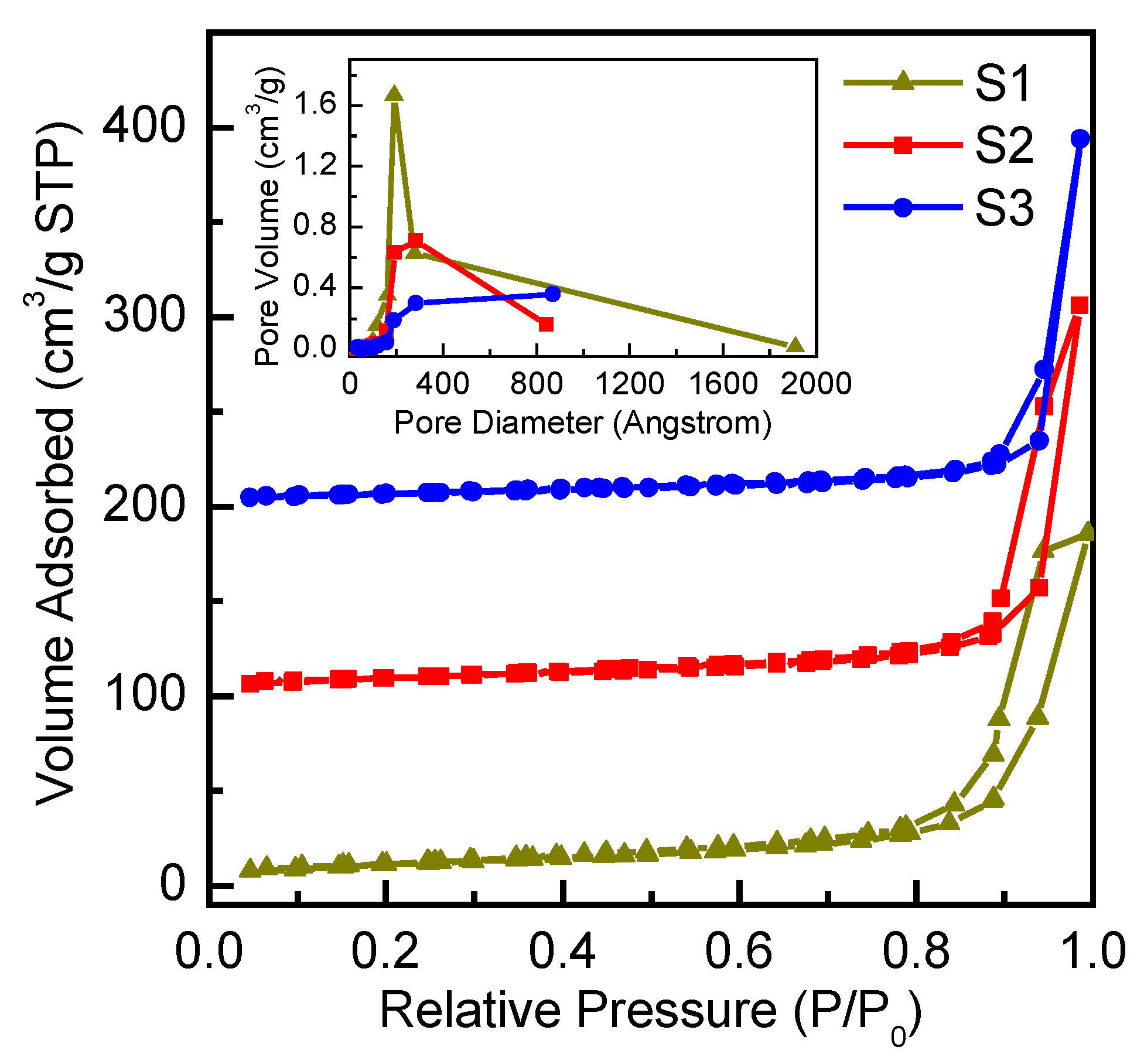
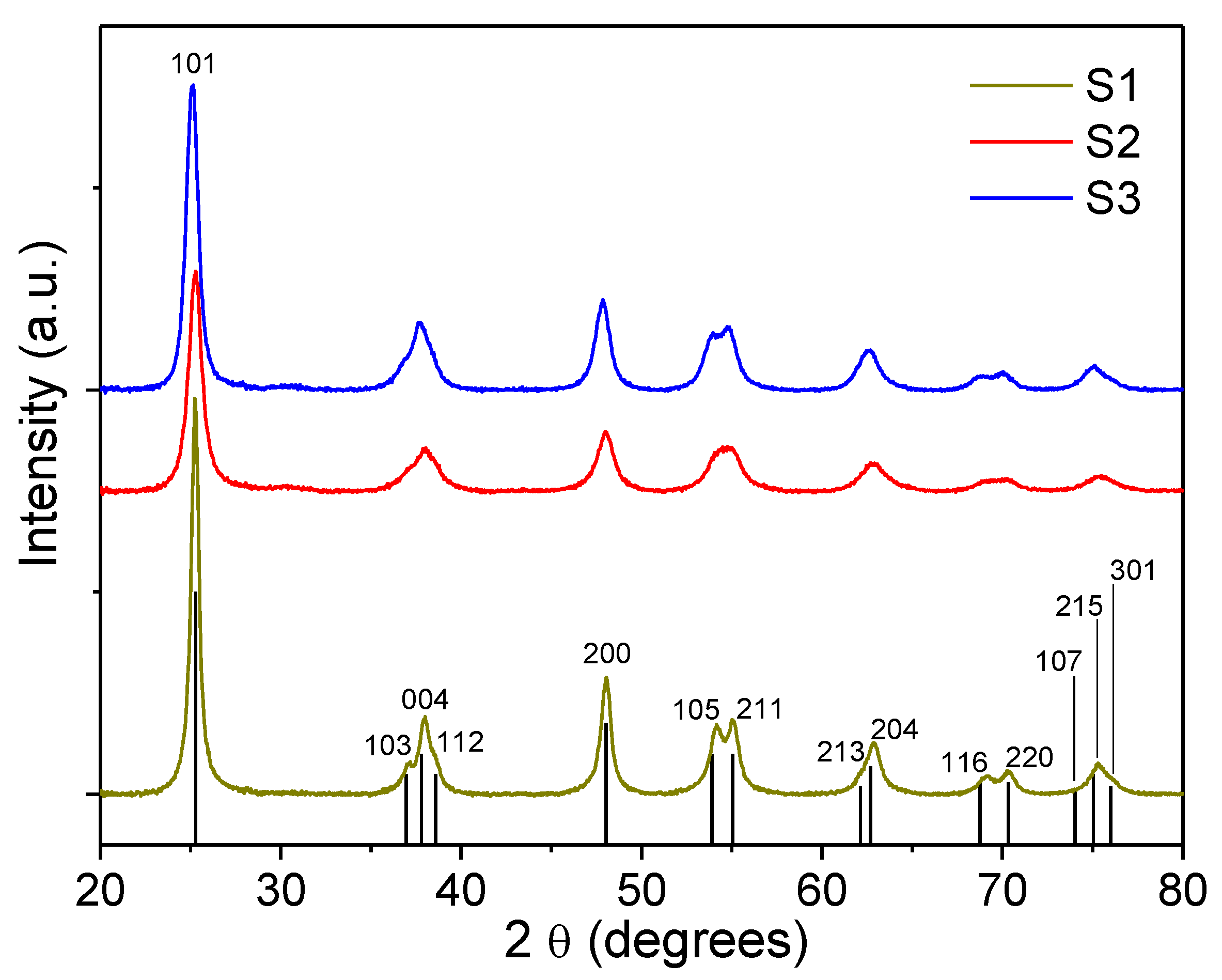
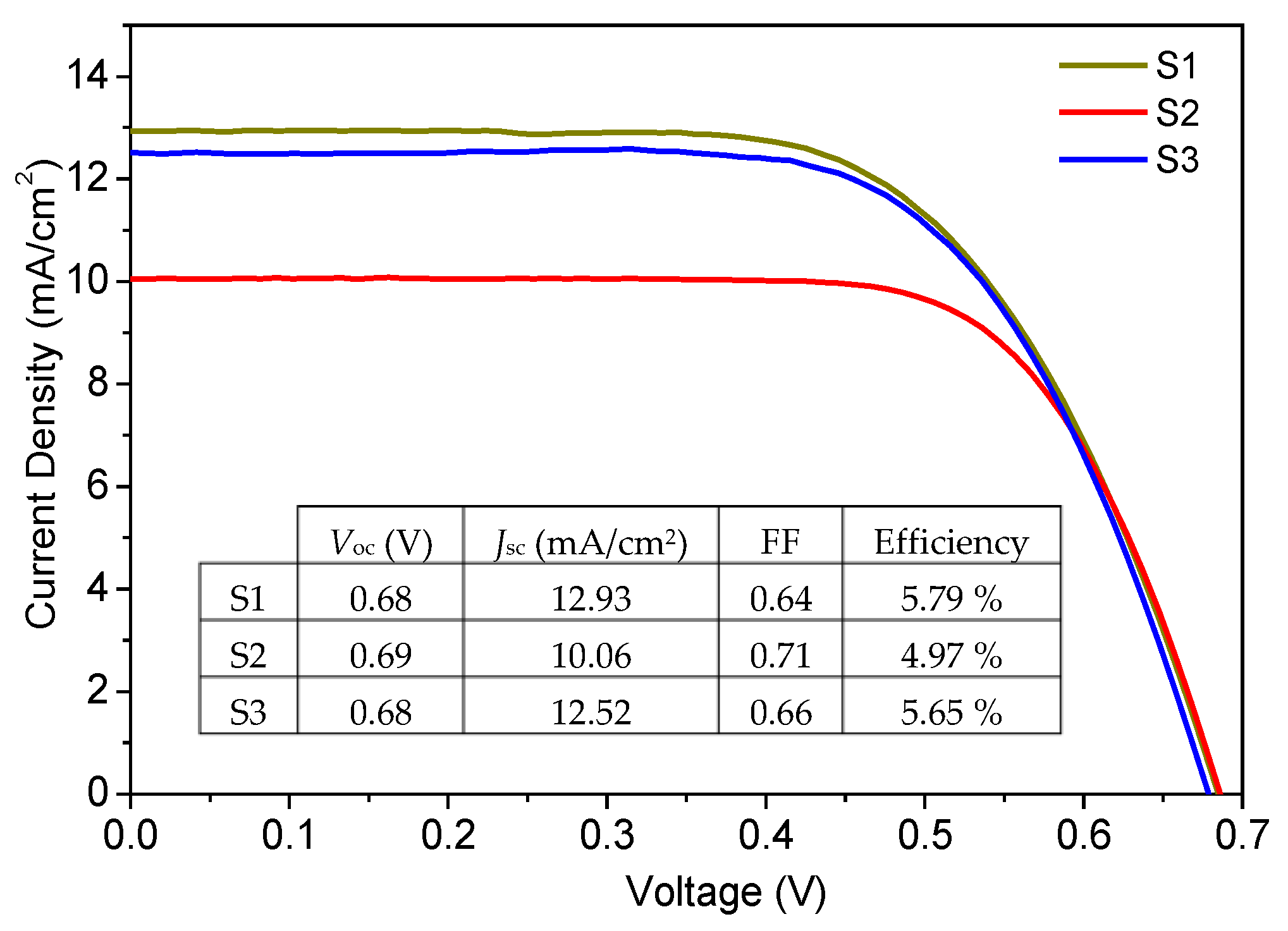
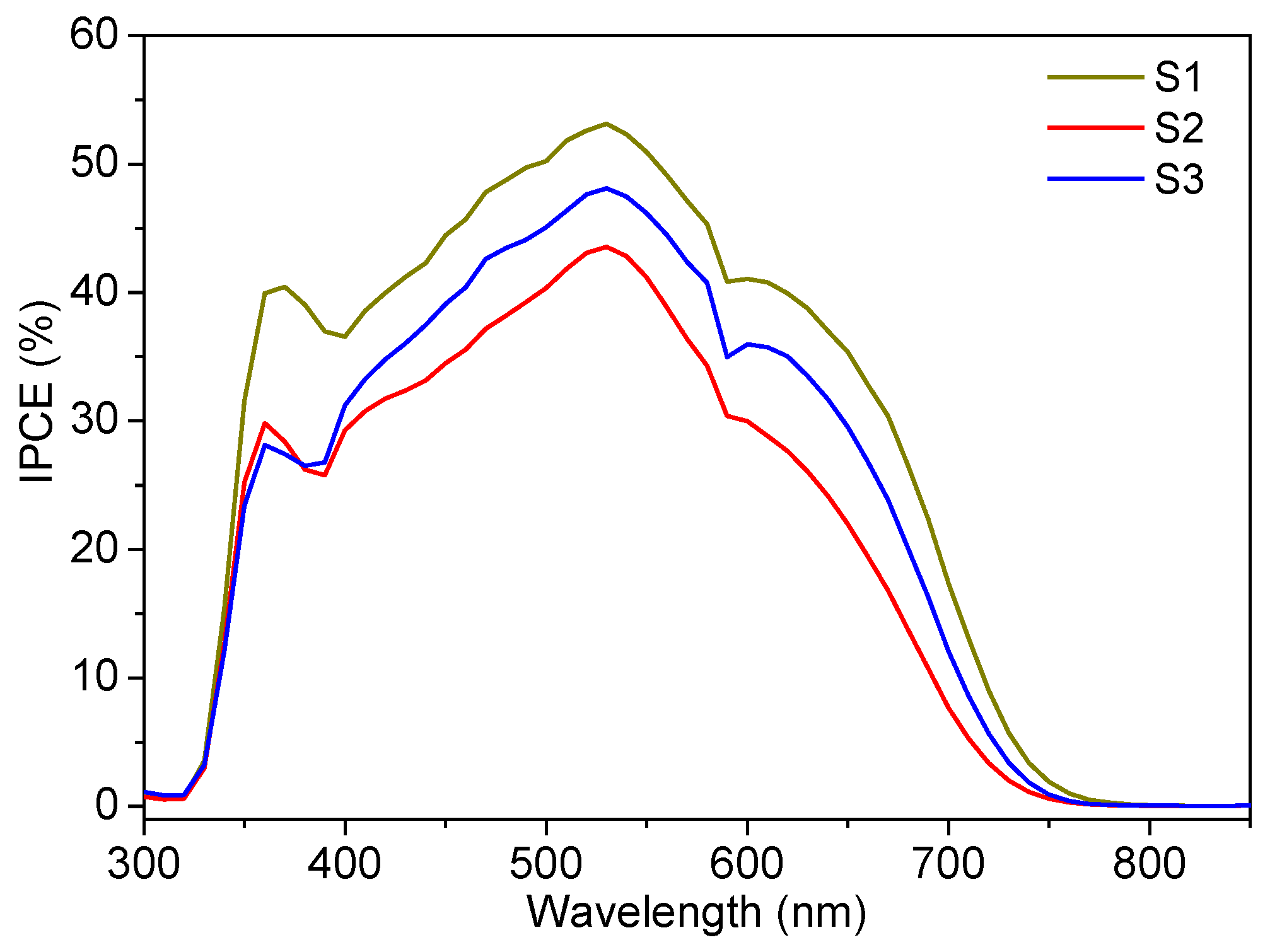
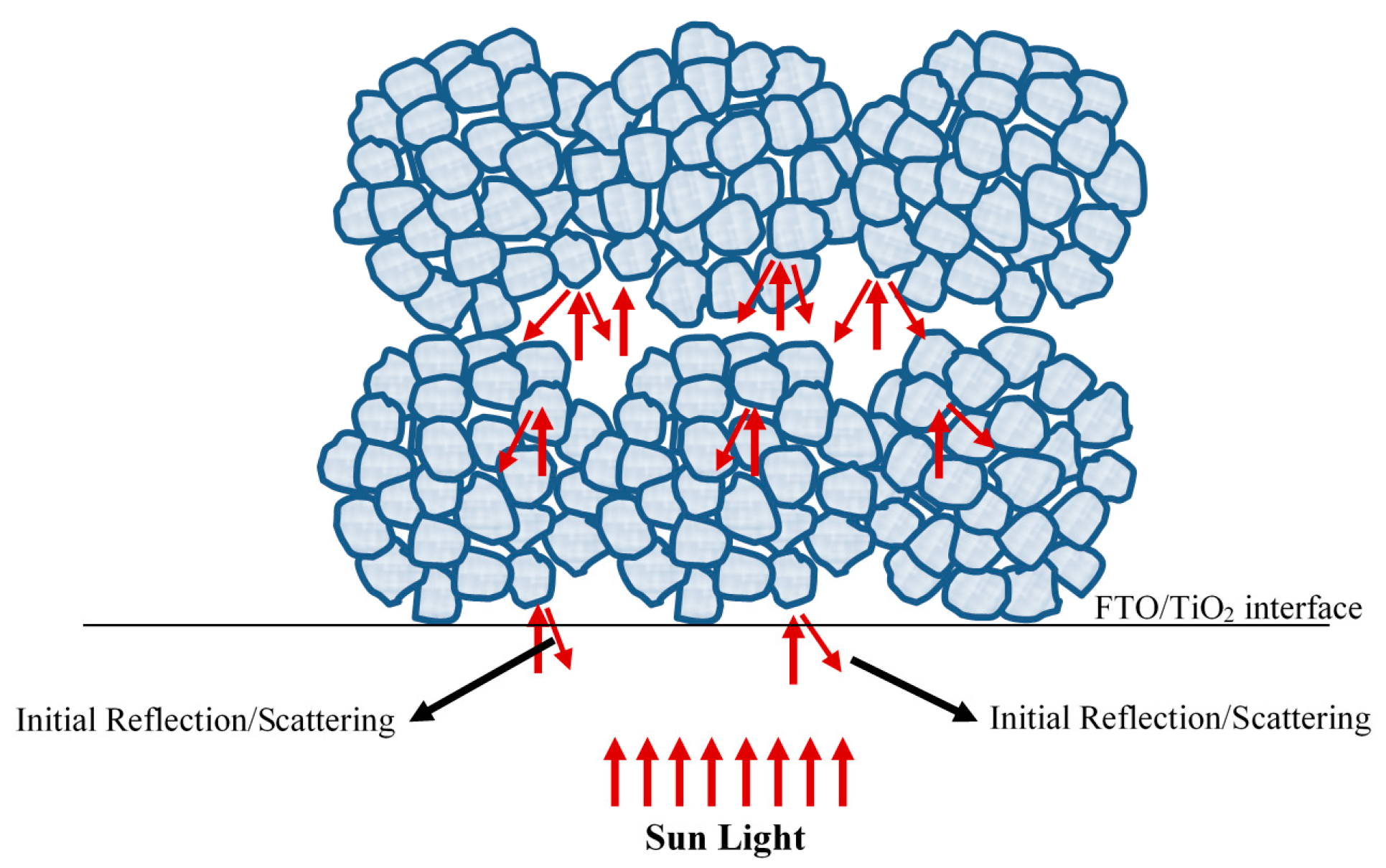
| Sample | Surface Area (m2/g) | Pore Volume (cm3/g) | Pore Size (nm) |
|---|---|---|---|
| S1 | 40.1 | 0.29 | 20 |
| S2 | 33.9 | 0.32 | 28 |
| S3 | 23.7 | 0.30 | 28 |
| Sample | Voc (V) | Jsc (mA/cm2) | Pmax (mW/cm2) | FF | Efficiency (%) |
|---|---|---|---|---|---|
| S1 | 0.672 ± 0.017 | 13.202 ± 0.392 | 0.963 ± 0.152 | 0.575 ± 0.093 | 5.173 ± 0.870 |
| S2 | 0.678 ± 0.011 | 9.987 ± 0.098 | 0.911 ± 0.019 | 0.711 ± 0.004 | 4.912 ± 0.086 |
| S3 | 0.676 ± 0.003 | 12.139 ± 0.545 | 1.023 ± 0.043 | 0.659 ± 0.004 | 5.499 ± 0.212 |
© 2020 by the authors. Licensee MDPI, Basel, Switzerland. This article is an open access article distributed under the terms and conditions of the Creative Commons Attribution (CC BY) license (http://creativecommons.org/licenses/by/4.0/).
Share and Cite
Alduraibi, M.; Hezam, M.; Al-Ruhaimi, B.; El-Toni, A.M.; Algarni, A.; Abdel-Rahman, M.; Qing, W.; Aldwayyan, A. Rapid Room-Temperature Synthesis of Mesoporous TiO2 Sub-Microspheres and Their Enhanced Light Harvesting in Dye-Sensitized Solar Cells. Nanomaterials 2020, 10, 413. https://doi.org/10.3390/nano10030413
Alduraibi M, Hezam M, Al-Ruhaimi B, El-Toni AM, Algarni A, Abdel-Rahman M, Qing W, Aldwayyan A. Rapid Room-Temperature Synthesis of Mesoporous TiO2 Sub-Microspheres and Their Enhanced Light Harvesting in Dye-Sensitized Solar Cells. Nanomaterials. 2020; 10(3):413. https://doi.org/10.3390/nano10030413
Chicago/Turabian StyleAlduraibi, Mohammad, Mahmoud Hezam, Bader Al-Ruhaimi, Ahmed Mohamed El-Toni, Ahmad Algarni, M. Abdel-Rahman, Wang Qing, and Abdullah Aldwayyan. 2020. "Rapid Room-Temperature Synthesis of Mesoporous TiO2 Sub-Microspheres and Their Enhanced Light Harvesting in Dye-Sensitized Solar Cells" Nanomaterials 10, no. 3: 413. https://doi.org/10.3390/nano10030413





